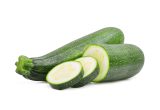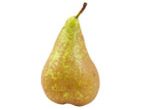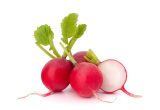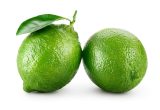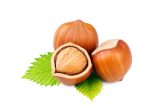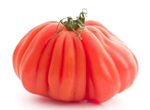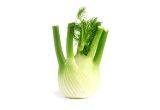Pomelo


Description
- Pomelo (Citrus paradisi) belongs to the Rutaceae family.
- The pomelo and the grapefruit (Citrus maxima or grandis) are often confused. Although they are two distinct fruits, both names are actually used for the pomelo, the only one of the two that is eaten in France.
- The pomelo is thought to be derived from a cross between Citrus maxima (grapefruit tree) and Citrus sinensis (orange tree) (Cirad, 2018).
PHYSICAL AND ORGANOLEPTIC CHARACTERISTICS
- The flesh of the pomelo can be white, pink or red, with the color influenced by the carotenoid composition (Zhen, 2016):
- the red color of pink grapefruit is due to the presence of lycopene (Costa, 2012 ; Zhen, 2016);
- Pomelos with white flesh contain more β-carotene (Zheng, 2016).
- A total of 170 aromatic compounds were found in pomelo pulp. Among them, 20 monoterpenes (43-70%), 48 sesquiterpenes (11-45%), 21 terpene alcohols and aldehydes, 18 aliphatic alcohols and aldehydes, 9 ketones, 21 esters, 21 alkanes and 12 other categories. According to this analysis, the most quantitatively represented compounds are D-limonene (30.07-67.55%), caryophyllene (9.90-25.69%), b-pinene (2.29-48.09%) and a-humulene (0-3.73%) (Zheng, 2016).
- The aroma of pomelo is believed to result from a mixture of caryophyllene (a sesquiterpene), citral (isomer), nootkatonne (sesquiterpene ketone) and various aldehydes such as octanal, nonanal and decanal (Gous, 2019). The most important aromatic compound in pomelo is thought to be nooktkatone (Furusawa, 2005).
- Pomelo is a sweet fruit, but its sugar content is not expected due to its bitterness and acidity (JAMA, 2018).
- The bitterness is mainly due to the presence of naringin and limonin (Gous AGS, 2019) and the acidity comes from the organic acids it contains (30-45 mg/g FW) (Zheng, 2016 ; JAMA, 2018). Citric acid accounts for 40-60% of the total organic acids and quinic acid is the second most important organic acid (15-30% of total organic acids) (Zheng, 2016).
COMPOSITION CHARACTERISTICS (excluding macronutrients, vitamins and minerals)
- Pomelo contains polyphenols including narirutin, naringin and poncirin (Chaudhary, 2012). Naringin is said to have many properties such as antioxidant, lipid-lowering and anti-cancer (Mallick, 2016). It is also said to improve ketoacidosis, which is the production of highly acidic compounds in the blood (one of the consequences of diabetes) (Murunga, 2016).
- Thanks to the phytochemicals it contains (such as polyphenols, including flavonoids, and carotenoids), pomelo has antioxidant (Kumar, 2019) and anti-inflammatory activity, and thus is thought to have a beneficial effect on intestinal inflammation (Khan, 2016).
- Storage of pomelos at low temperature (5 or 11 °C) is not thought to significantly affect their β-carotene and polyphenol composition (Chaudhary PR, 2016).
- Phyto-nutrients in pomelo, such as limonene, are believed to reduce cholesterol and triglyceride synthesis, and thus have beneficial effects against hyperlipidemia and cardiovascular risks (Mallick, 2016 ; Lin, 2020). Consumption of pomelo is therefore thought to reduce systolic blood pressure (Onakpoya, 2017).
- Finally, the ascorbic acid in pomelo acts as a powerful antioxidant and is believed to have preventive effects on cardiovascular risks and certain cancers (Kumar, 2019).
FRESH
The following values are approximate and depend on variety, season, ripeness, cultivation conditions, etc. Pomelo is low in energy*. On average, it provides 39.80 calories (kcal) per 100 g, i.e. 169 kJ.
COMPOSITION TABLES
For each nutrient, the tables provide information on the content, minimum and maximum values and percentage of the Dietary Reference Values (DRVs) per 100 g net of pomelo (pulp).
* Regulation (EC) No 1924/2006 of the European Parliament and of the Council of 20 December 2006 on nutrition and health claims made on foods.
MACRONUTRIENTS
| Constituent (g) | Average content |
Min-Max per 100g |
DRV% |
|---|---|---|---|
| Water | 89,30 | 87,90 - 90,90 | - |
| Fibers | 0,80 | NC - 1,80 | - |
| Carbohydrates | 8,02 | - | 3,08 |
| Sugars | 6,60 | 5 - 6,98 | 7,33 |
| Lipids | < 0,50 | 0,10 - NC | - |
| Saturated fat | < 0,01 | NC - 0,076 | - |
| Protein | < 0,50 | NC - 0,90 | - |
| Constituent (g) | Amount | Min-Max | DRV% |
|---|---|---|---|
| Water | Ciqual 2020 (valeur issue des analyses Ciqual-Aprifel 2017) | - | - |
| Fibers | Ciqual 2020 (valeur issue des analyses Ciqual-Aprifel 2017) | - | - |
| Carbohydrates | Ciqual 2020 | - | Règlement (UE) N°1169/2011 du parlement Européen, et du conseil du 25 octobre 2011 |
| Sugars | Ciqual 2020 (valeur issue des analyses Ciqual-Aprifel 2017) | - | Règlement (UE) N°1169/2011 du parlement Européen, et du conseil du 25 octobre 2011 |
| Lipids | Ciqual 2020 (valeur issue des analyses Ciqual-Aprifel 2017) | - | Règlement (UE) N°1169/2011 du parlement Européen, et du conseil du 25 octobre 2011 |
| Saturated fat | Ciqual 2020 (valeur issue des analyses Ciqual-Aprifel 2017) | - | Règlement (UE) N°1169/2011 du parlement Européen, et du conseil du 25 octobre 2011 |
| Protein | Ciqual 2020 (valeur issue des analyses Ciqual-Aprifel 2017) | - | Règlement (UE) N°1169/2011 du parlement Européen, et du conseil du 25 octobre 2011 |
Zoom on carbohydrates
- The carbohydrate content (8.02 g per 100 g) is also lower than the average amount contained in fresh fruit (11.31 g per 100 g).
- These are mainly sucrose (2.80 g per 100 g), fructose (1.90 g per 100 g) and glucose (1.90 g per 100 g).
Zoom on fibres
- Pomelos contain less fibre (0.80 g per 100 g) than the average amount found in fresh fruit (2.77 g per 100 g).
Zoom on lipids
- Pomelo is fat-free* as it contains less than 0.5 g of fat per 100 g.
* Regulation (EC) No 1924/2006 of the European Parliament and of the Council of 20 December 2006 on nutrition and health claims made on foods.
MINERALS AND TRACE ELEMENTS
| Constituent | Average content |
Min-Max per 100g |
DRV% |
|---|---|---|---|
| Calcium (mg) | 14 | 12 - 47 | 1,75 |
| Chloride (mg) | < 20 | - | - |
| Copper (mg) | 0,02 | NC - 0,051 | 2 |
| Iron (mg) | 0,06 | 0,015 - 0,19 | 0,43 |
| Iodine (µg) | < 20 | 0,05 - NC | - |
| Magnesium (mg) | 7,20 | NC - 12,20 | 1,92 |
| Manganese (mg) | 0,02 | 0,012 - 0,055 | 1 |
| Phosphorus (mg) | 17 | 8 - 26,40 | 2,43 |
| Potassium (mg) | 140 | 131 - 157 | 7 |
| Selenium (µg) | < 20 | 0,22 - NC | - |
| Sodium (mg) | < 5 | 0 - NC | - |
| Zinc (mg) | 0,07 | 0,045 - 0,10 | 0,70 |
| Constituent | Amount | Min-Max | DRV% |
|---|---|---|---|
| Calcium (mg) | Ciqual 2020 (valeur issue des analyses Ciqual-Aprifel 2017) | - | Règlement (UE) N°1169/2011 du parlement Européen, et du conseil du 25 octobre 2011 |
| Chloride (mg) | Ciqual 2020 (valeur issue des analyses Ciqual-Aprifel 2017) | - | Règlement (UE) N°1169/2011 du parlement Européen, et du conseil du 25 octobre 2011 |
| Copper (mg) | Ciqual 2020 (valeur issue des analyses Ciqual-Aprifel 2017) | - | Règlement (UE) N°1169/2011 du parlement Européen, et du conseil du 25 octobre 2011 |
| Iron (mg) | Ciqual 2020 (valeur issue des analyses Ciqual-Aprifel 2017) | - | Règlement (UE) N°1169/2011 du parlement Européen, et du conseil du 25 octobre 2011 |
| Iodine (µg) | Ciqual 2020 (valeur issue des analyses Ciqual-Aprifel 2017) | - | Règlement (UE) N°1169/2011 du parlement Européen, et du conseil du 25 octobre 2011 |
| Magnesium (mg) | Ciqual 2020 (valeur issue des analyses Ciqual-Aprifel 2017) | - | Règlement (UE) N°1169/2011 du parlement Européen, et du conseil du 25 octobre 2011 |
| Manganese (mg) | Ciqual 2020 (valeur issue des analyses Ciqual-Aprifel 2017) | - | Règlement (UE) N°1169/2011 du parlement Européen, et du conseil du 25 octobre 2011 |
| Phosphorus (mg) | Ciqual 2020 (valeur issue des analyses Ciqual-Aprifel 2017) | - | Règlement (UE) N°1169/2011 du parlement Européen, et du conseil du 25 octobre 2011 |
| Potassium (mg) | Ciqual 2020 (valeur issue des analyses Ciqual-Aprifel 2017) | - | Règlement (UE) N°1169/2011 du parlement Européen, et du conseil du 25 octobre 2011 |
| Selenium (µg) | Ciqual 2020 (valeur issue des analyses Ciqual-Aprifel 2017) | - | Règlement (UE) N°1169/2011 du parlement Européen, et du conseil du 25 octobre 2011 |
| Sodium (mg) | Ciqual 2020 (valeur issue des analyses Ciqual-Aprifel 2017) | - | - |
| Zinc (mg) | Ciqual 2020 (valeur issue des analyses Ciqual-Aprifel 2017) | - | Règlement (UE) N°1169/2011 du parlement Européen, et du conseil du 25 octobre 2011 |
Zoom on minerals and trace elements
- Pomelo provides the equivalent of 7% of DRVs for potassium, i.e. 140 mg per 100 g.
- The amount of other minerals and trace elements represents less than 3% of DRVs.
VITAMINS
| Constituent | Average content |
Min-Max per 100g |
DRV% |
|---|---|---|---|
| Provitamin A Beta-carotene (µg) | 539 | NC - 552 | - |
| Vitamin A equivalent (µg) | 89,83 | NC - 92 | 11,23 |
| Vitamin B1 (mg) | 0,043 | 0,036 - 0,055 | 3,91 |
| Vitamin B2 (mg) | < 0,01 | NC - 0,048 | - |
| Vitamin B3 (mg) | < 0,10 | NC - 0,42 | - |
| Vitamin B5 (mg) | 0,19 | NC - 0,28 | 3,17 |
| Vitamin B6 (mg) | 0,36 | 0,025 - NC | 25,71 |
| Vitamin B9 (µg) | 52,90 | 10 - NC | 26,45 |
| Vitamin C (mg) | 42,40 | 34,40 - 47,30 | 53 |
| Vitamin E (mg) | < 0,08 | NC - 0,34 | - |
| Vitamin K1 (µg) | < 0,80 | 0 - NC | - |
| Constituent | Amount | Min-Max | DRV% |
|---|---|---|---|
| Provitamin A Beta-carotene (µg) | Ciqual 2020 (valeur issue des analyses Ciqual-Aprifel 2017) | - | - |
| Vitamin A equivalent (µg) | Calcul à partir de la valeur Provitamine A Béta-carotène* | - | Règlement (UE) N°1169/2011 du parlement Européen, et du conseil du 25 octobre 2011 |
| Vitamin B1 (mg) | Ciqual 2020 (valeur issue des analyses Ciqual-Aprifel 2017) | - | Règlement (UE) N°1169/2011 du parlement Européen, et du conseil du 25 octobre 2011 |
| Vitamin B2 (mg) | Ciqual 2020 (valeur issue des analyses Ciqual-Aprifel 2017) | - | Règlement (UE) N°1169/2011 du parlement Européen, et du conseil du 25 octobre 2011 |
| Vitamin B3 (mg) | Ciqual 2020 (valeur issue des analyses Ciqual-Aprifel 2017) | - | Règlement (UE) N°1169/2011 du parlement Européen, et du conseil du 25 octobre 2011 |
| Vitamin B5 (mg) | Ciqual 2020 (valeur issue des analyses Ciqual-Aprifel 2017) | - | Règlement (UE) N°1169/2011 du parlement Européen, et du conseil du 25 octobre 2011 |
| Vitamin B6 (mg) | Ciqual 2020 (valeur issue des analyses Ciqual-Aprifel 2017) | - | Règlement (UE) N°1169/2011 du parlement Européen, et du conseil du 25 octobre 2011 |
| Vitamin B9 (µg) | Ciqual 2020 (valeur issue des analyses Ciqual-Aprifel 2017) | - | Règlement (UE) N°1169/2011 du parlement Européen, et du conseil du 25 octobre 2011 |
| Vitamin C (mg) | Ciqual 2020 (valeur issue des analyses Ciqual-Aprifel 2017) | - | Règlement (UE) N°1169/2011 du parlement Européen, et du conseil du 25 octobre 2011 |
| Vitamin E (mg) | Ciqual 2020 (valeur issue des analyses Ciqual-Aprifel 2017) | - | Règlement (UE) N°1169/2011 du parlement Européen, et du conseil du 25 octobre 2011 |
| Vitamin K1 (µg) | Ciqual 2020 (valeur issue des analyses Ciqual-Aprifel 2017) | - | Règlement (UE) N°1169/2011 du parlement Européen, et du conseil du 25 octobre 2011 |
Zoom on vitamins
- Pomelo is high in vitamin C as it provides the equivalent of 53% of DRVs, i.e. 42.40 mg per 100 g.
- It is also a source of:
- vitamin B9 as it provides the equivalent of 26.45% of DRVs, i.e. 52.90 µg per 100 g;
- vitamin B6 as it provides the equivalent of 25.71% of DRVs, i.e. 0.36 mg per 100 g.
According to the data of the Ciqual 2020 table, pomelo is the fruit that contains the most vitamin B6.
- It contains a significant amount of vitamin A (89.83 µg per 100 g), i.e. 11.23% of DRVs.
- The quantity of other vitamins represents less than 4% of DRVs.
*Calculation made: Beta Carotene / 6 + retinol
POLYPHENOLS
| Constituent (mg) | Average content |
Min-Max per 100mg |
|---|---|---|
| Flavonoids (mg) | 55,10 | 54,50 - 55,40 |
| of which Flavonols (mg) | 0,60 | 0 - 0,90 |
| of which Flavanones (mg) | 54,50 | 54,50 - 54,50 |
| of which Hydroxybenzoic acids (mg) | 0,96 | 0,96 - 0,96 |
| of which Hydroxycinnamic acids (mg) | 6,92 | 6,92 - 6,92 |
| Lignanes (mg) | 10,82 | 0,006 - 15,10 |
| Total polyphenols | 73,80 | 62,39 - 78,38 |
| Constituent (mg) | Amount | Min-Max |
|---|---|---|
| Flavonoids | Phénol-Explorer version3.6 Méthode itilisée : chromatographie après hydrolyse | - |
| of which Flavonols | Phénol-Explorer version3.6 Méthode itilisée : chromatographie après hydrolyse | - |
| of which Flavanones | Phénol-Explorer version3.6 Méthode itilisée : chromatographie après hydrolyse | - |
| of which Hydroxybenzoic acids | Phénol-Explorer version3.6 Méthode itilisée : chromatographie après hydrolyse | - |
| of which Hydroxycinnamic acids | Phénol-Explorer version3.6 Méthode itilisée : chromatographie après hydrolyse | - |
| Lignanes | Phénol-Explorer version3.6 Méthode itilisée : chromatographie après hydrolyse | - |
| Total polyphenols | Phénol-Explorer version3.6 Méthode itilisée : chromatographie après hydrolyse | - |
Zoom on polyphenols
- Polyphenols are substances with an antioxidant effect.
- Flavanones, a subgroup of flavonoids, are the main polyphenols present in pomelo, representing 73.85% of the total polyphenols identified.
- Next come lignans, which represent 14.66% of total polyphenols, and hydroxycinnamic acids (a subgroup of phenolic acids) with 9.38% of total polyphenols.
- Hydroxybenzoic acids (subgroup of phenolic acids) and flavonols (subgroup of flavonoids) are present in smaller quantities. They represent respectively 1.30% and 0.81% of total polyphenols.
Nutrition and health claims
According to the definitions of nutrition claims as set out in Regulation (EC) No 1924/2006 on nutrition and health claims, and in view of the composition of pomelo, the following claims may be used:
NUTRITION CLAIMS OF POMELO
- Low in energy (100 g of pomelo provide less than 40 kcal)
- Fat-free (100 g of pomelo do not contain more than 0.5 g of fat)
- High in vitamin C (100 g of pomelo provide more than 30% of DRVs)
- Source of vitamin B9 (100 g of pomelo provide more than 15% of DRVs)
- Source of vitamin B6 (100 g of pomelo provide more than 15% of DRVs)
HEALTH CLAIMS (for a consumption of 100 g of pomelo)
Vitamin C
- Vitamin C contributes to:
- normal function of the immune system during and after intense physical exercise,
- normal collagen formation for the normal function of blood vessels,
- normal collagen formation for the normal function of bones,
- normal collagen formation for the normal function of cartilage,
- normal collagen formation for the normal function of gums,
- normal collagen formation for the normal function of skin,
- normal collagen formation for the normal function of teeth,
- normal energy-yielding metabolism,
- normal functioning of the nervous system,
- normal psychological function,
- normal function of the immune system,
- protection of cells from oxidative stress,
- reduction of tiredness and fatigue,
- regeneration of the reduced form of vitamin E.
- Vitamin C increases iron absorption.
Folates or vitamin B9
- Folates contribute to:
- maternal tissue growth during pregnancy,
- normal amino acid synthesis,
- normal blood formation,
- normal homocysteine metabolism,
- normal psychological function,
- normal function of the immune system,
- reduction of tiredness and fatigue.
- Folates have a role in the process of cell division.
Vitamin B6
- Vitamin B6 contributes to:
- normal cysteine synthesis,
- normal homocysteine metabolism,
- normal energy-yielding metabolism,
- normal functioning of the nervous system,
- normal protein and glycogen metabolism,
- normal psychological function,
- normal red blood cell formation,
- normal function of the immune system,
- reduction of tiredness and fatigue,
- regulation of hormonal activity.
References
- Agence nationale de sécurité sanitaire de l’alimentation, de l’environnement et du travail. Table de composition nutritionnelle des aliments Ciqual 2020. Consultée le 08/09/2020 depuis le site internet Ciqual https://ciqual.anses.fr/
- Chaudhary P, Jayaprakasha GK, Porat R, Patil BS. Degreening and postharvest storage influences ‘Star Ruby’ grapefruit (Citrus paradisi Macf.) bioactive compounds. Food Chem. 2012;135(3):1667-75.
- Chaudhary PR, Yu X, Jayaprakasha GK, Patil BS. Influence of storage temperature and low-temperature conditioning on the levels of health-promoting compounds in Rio Red grapefruit. Food Sci Nutr. 2016;5(3):545-53.
- Cirad – La recherche agronomique pour le développement. L’évolution des agrumes revisitée (communiqué de presse du 08 février 2018). [En ligne] [Consulté le 27 mars 2020] Disponible à l’adresse : https://www.cirad.fr/actualites/toutes-les-actualites/communiques-de-presse/2018/l-evolution-des-agrumes-revisitee
- Costa MG, Moreira CD, Melton JR, Otoni WC, Moore GA. Characterization and developmental expression of genes encoding the early carotenoid biosynthetic enzymes in Citrus paradisi Macf. Mol Biol Rep. 2012;39(2):895-902.
- Furusawa M, Hashimoto T, Noma Y, Asakawa Y. Highly efficient production of nootkatone, the grapefruit aroma from valencene, by biotransformation. Chem Pharm Bull (Tokyo). 2005;53(11):1513-4.
- Gous AGS, Almli VL, Coetzee V, de Kock HL. Effects of Varying the Color, Aroma, Bitter, and Sweet Levels of a Grapefruit-Like Model Beverage on the Sensory Properties and Liking of the Consumer. Nutrients. 2019;11(2).
- JAMA. The pomelo or grapefruit. JAMA. 2018;319(20):2140.
- Khan RA, Mallick N, Feroz Z. Anti-inflammatory effects of Citrus sinensis L., Citrus paradisi L. and their combinations. Pak J Pharm Sci. 2016;29(3):843-52.
- Kumar D, Ladaniya MS, Gurjar M. Underutilized Citrus sp. Pomelo (Citrus grandis) and Kachai lemon (Citrus jambhiri) exhale in phytochemicals and antioxidant potential. J Food Sci Technol. 2019;56(1):217-223
- Lin LY, Huang BC, Chen KC, Peng RY. Integrated anti-hyperlipidemic bioactivity of whole Citrus grandis [L.] osbeck fruits-multi-action mechanism evidenced using animal and cell models. Food Funct. 2020;11(4):2978-2996
- Mallick N, Khan RA. Antihyperlipidemic effects of Citrus sinensis, Citrus paradisi, and their combinations. J Pharm Bioallied Sci. 2016;8(2):112-8.
- Murunga AN, Miruka DO, Driver C, Nkomo FS, Cobongela SZ, Owira PM. Grapefruit Derived Flavonoid Naringin Improves Ketoacidosis and Lipid Peroxidation in Type 1 Diabetes Rat Model. PLoS One. 2016;11(4):e0153241.
- Neveu V, Perez-Jiménez J, Vos F, Crespy V, du Chaffaut L, Mennen L, Knox C, Eisner R, Cruz J, Wishart D, Scalbert A. (2010) Phenol-Explorer: an online comprehensive database on polyphenol contents in foods. Database, doi: 10.1093/database/bap024. Full text (free access)
- Onakpoya I, O’Sullivan J, Heneghan C, Thompson M. The effect of grapefruits (Citrus paradisi) on body weight and cardiovascular risk factors: A systematic review and meta-analysis of randomized clinical trials. Crit Rev Food Sci Nutr. 2017;57(3):602-612.
- Règlement (CE) N° 1924/2006 du Parlement européen et du Conseil du 20 décembre 2006 concernant les allégations nutritionnelles et de santé portant sur les denrées alimentaires.
- Règlement (UE) N°432/2012 de la Commission du 16 mai 2012 établissant une liste des allégations de santé autorisées portant sur les denrées alimentaires, autres que celles faisant référence à la réduction du risque de maladie ainsi qu’au développement et à la santé infantiles.
- Règlement (UE) n°1169/2011 du Parlement européen et du Conseil du 25 octobre 2011 concernant l’information des consommateurs sur les denrées alimentaires, modifiant les règlements (CE) n°1924/2006 et (CE) n°1925/2006 du Parlement européen et de Conseil et abrogeant la directive 87/250/CEE de la Commission, la directive 90/496/CEE du Conseil, la directive 1999/10/CE de la Commission, la directive 200/13/CE du Parlement européen et du Conseil, les directives 2002/67/CE et 2008/5/CE de la Commission et le règlement (CE) n°608/2004 de la Commission.
- Zheng H, Zhang Q, Quan J, Zheng Q, Xi W. Determination of sugars, organic acids, aroma components, and carotenoids in grapefruit pulps. Food Chem. 2016;205:112-21.





